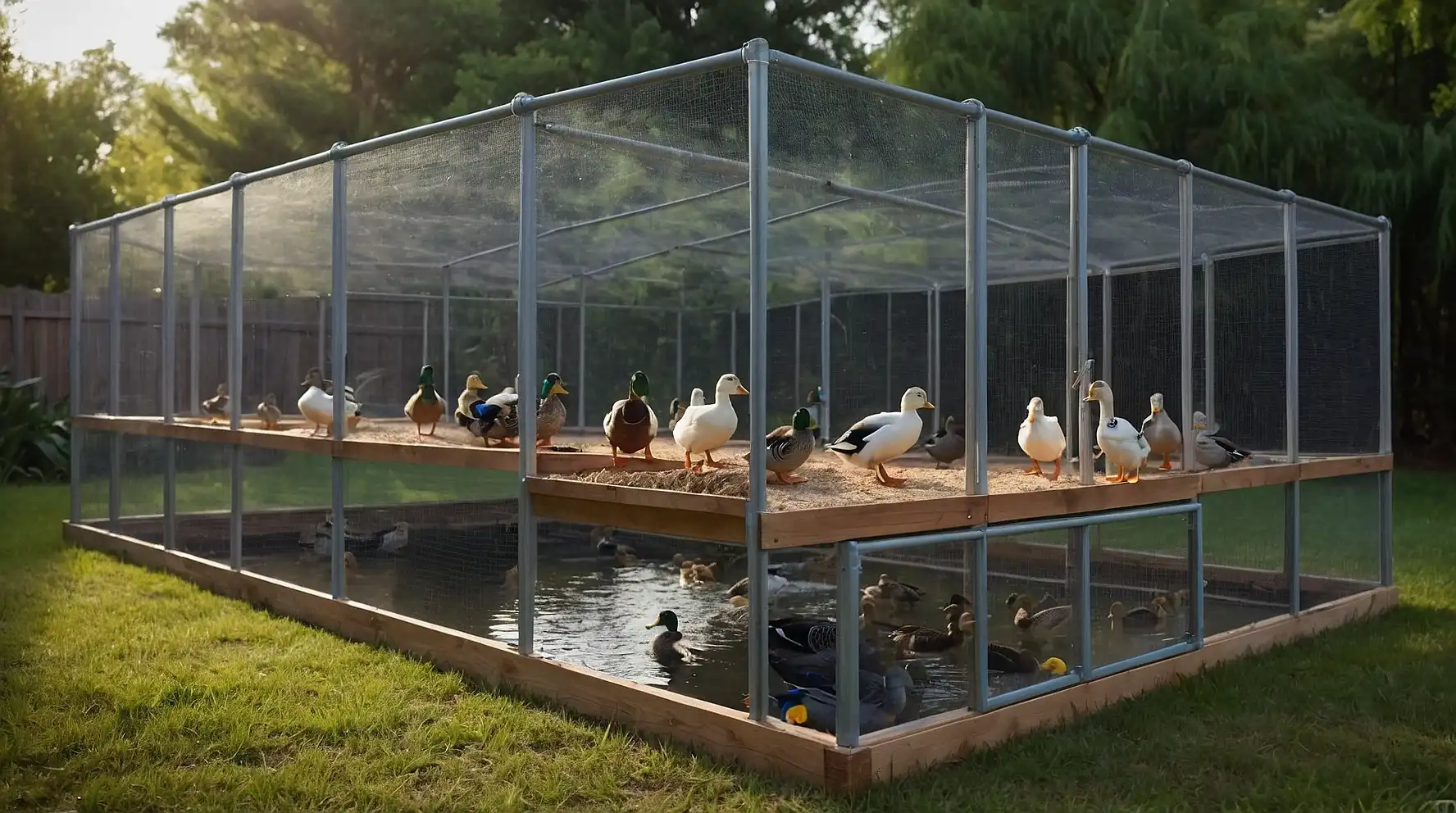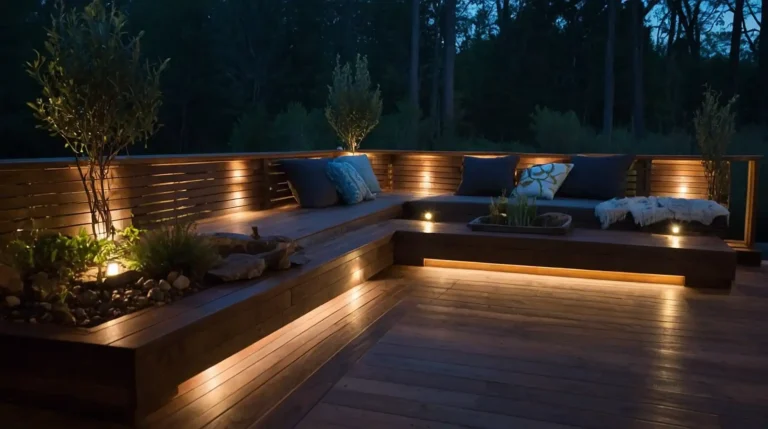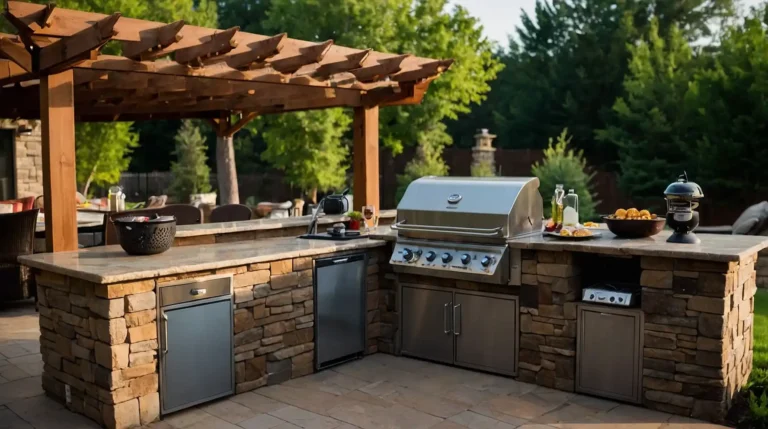27 Creative DIY Duck Enclosure Ideas That Keep Your Feathered Friends Safe and Happy
Creating the perfect home for your ducks requires balancing safety, comfort, and practicality.
A well-designed duck enclosure protects your feathered friends from predators while providing access to essential elements like water, shelter, and foraging areas.
Whether you have a small backyard flock or a larger homestead setup, you can build an enclosure that meets your ducks’ needs without breaking the bank.
DIY approaches allow you to customize features specifically for your situation and climate.
These 27 creative enclosure ideas will inspire you to create the ideal duck habitat, using everything from repurposed materials to clever design solutions that make duck-keeping easier and more enjoyable.
1: Converted Playhouse Coop

Transform a secondhand children’s playhouse into a charming duck coop.
The existing structure provides excellent shelter while requiring minimal modification to accommodate your ducks.
Add a ramp for easy access and replace any flooring with rubber mats or straw for better cleaning.
Install secure hardware cloth over windows and any openings to ensure predator protection.
This approach creates an attractive backyard feature while providing comfortable housing that will last for years with minimal construction skills required.
2: Livestock Panel Dome

Create a lightweight, movable duck run using livestock panels bent into a dome shape.
This simple structure requires minimal materials while creating a surprisingly spacious enclosure.
Secure the panels to each other using zip ties or wire, then cover with hardware cloth or chicken wire for additional protection.
The arched shape sheds snow and allows excellent airflow.
The resulting dome allows your ducks protected foraging access while being easily relocatable to fresh areas of your yard or garden.
3: Repurposed Garden Shed

Convert an existing garden shed into a deluxe duck house by adding some duck-friendly features.
The solid structure already provides excellent weather protection and security.
Install nest boxes along one wall and add a splash pool in one corner with proper drainage.
Cut duck-sized doors at ground level for easy access to an attached outdoor run.
This substantial structure works perfectly for larger flocks or extreme weather conditions while giving you convenient storage space for feed and supplies.
4: Floating Pond House

Build a small floating shelter that sits directly on your pond surface.
Construct a simple platform with treated lumber, adding flotation underneath and a small shelter on top.
Secure with anchors or tether to shore while ensuring stability. This design provides excellent predator protection as many cannot reach ducks on water.
Your ducks will appreciate the direct water access, especially during hot summer months when they can swim directly from their protected shelter.
5: Pallet Duck House

Construct an economical duck shelter using free wooden pallets as your primary building material.
Dismantle or use whole pallets to create walls, flooring, and roof structures.
Ensure all nails or staples are removed or pounded flat to prevent injuries. Apply a non-toxic sealant to protect the wood from moisture and extend its lifespan.
This recycled approach creates a sturdy shelter while keeping costs minimal and giving new purpose to materials that might otherwise end up in landfills.
6: Hoop House Run

Create an inexpensive covered run using PVC pipes bent into hoops and covered with hardware cloth or chicken wire.
The curved design maximizes usable space while shedding snow and rain effectively.
Space hoops every 2-3 feet and secure to a wooden base frame for stability.
Cover with appropriate fencing material and secure thoroughly to prevent predator entry.
This lightweight structure can be made in any length to suit your space constraints while providing safe outdoor access for your flock.
7: Chicken Tractor Adaptation

Modify the classic chicken tractor design to suit duck needs by adding more headroom and a water feature.
The mobile enclosure allows ducks to access fresh foraging ground regularly.
Install wheels on one end for easy moving and ensure the bottom frame is sturdy enough to prevent predators from pushing underneath.
Add removable trays under water areas for simple cleaning.
This versatile solution works well for small flocks and allows your ducks to contribute to lawn and garden care through pest control and fertilization.
8: Converted Trampoline Frame

Repurpose an old trampoline frame into a circular duck enclosure by removing the jumping surface and adding appropriate fencing material.
The existing frame provides excellent structural support.
Cover the top with netting or hardware cloth to prevent flying predators from accessing your ducks.
Create a secure shelter in the center or along one edge for weather protection.
This circular design eliminates corner areas where predators might focus their efforts while creating an attractive backyard feature with minimal construction required.
9: Split-Level Duck Habitat

Construct a two-story duck house with an elevated sleeping area and ground-level splash zone.
This design efficiently uses vertical space while keeping water activities separate from dry resting areas.
Build a sloped ramp connecting levels for easy duck access.
Include removable dividers to create separate spaces for different flock needs like nursery areas or isolation when needed.
This space-efficient design works well in limited areas while providing distinct microenvironments that support different duck behaviors and needs.
10: Predator-Proof Night Pen

Create a super-secure nighttime enclosure using welded wire with a buried perimeter to prevent digging predators.
Focus on making this smaller area exceptionally secure rather than fortifying a larger run.
Install motion-activated lights and possibly an alarm system for additional deterrence.
Ensure all hardware and locks are secure enough to thwart raccoons and other clever predators.
This approach allows more freedom during daylight hours while providing peace of mind during vulnerable nighttime periods when most predator attacks occur.
11: Dutch Door Duck House

Install a split “Dutch door” design on your duck house to increase ventilation while maintaining security.
The two-part door allows the top to open independently from the bottom section.
Use the bottom section to contain ducks when needed while opening the top for increased airflow during hot weather.
Add secure latches to both sections to prevent predator entry.
This practical feature improves coop conditions through better air circulation while giving you flexible access options for different situations and seasons.
12: Pond-Adjacent Enclosure

Design a secure enclosure that connects directly to a pond edge, giving ducks safe access to natural swimming.
Use hardware cloth fencing extending into the water with a duck-sized opening.
Create a protected walkway from the sleeping quarters to the pond access point.
The partial enclosure of natural water features gives ducks their preferred environment with added protection.
This integrated approach works with existing landscape features while satisfying ducks’ natural affinity for water access, resulting in healthier, happier birds.
13: Underground Duck Shelter

Build a partially subterranean duck house by digging into a hillside or creating beamed walls.
The earth-sheltered design provides excellent insulation and temperature stability throughout the seasons.
Ensure proper drainage around and under the structure to prevent moisture problems.
Install adequate ventilation through roof vents or windows placed above ground level.
This natural temperature regulation helps keep ducks comfortable during both summer heat and winter cold while blending attractively into the landscape.
14: Portable Nesting Wagon

Construct a mobile nesting area using an old wagon or cart as the base. Add a weatherproof top and nesting boxes inside with easy access for egg collection.
Include a ramp for duck entry and ensure the entire unit can be moved to different locations around your property.
This mobility allows rotation to fresh ground while keeping eggs in predictable locations.
This specialized addition complements a larger duck system while making egg collection more convenient and protecting nests from weather and predators.
15: Aquaponics Integration

Design a duck enclosure that channels waste water into an aquaponic growing system.
Position growing beds adjacent to the duck area with appropriate filtration between systems.
Create easy cleaning features that direct nutrient-rich water toward plants rather than requiring complete disposal.
This closed-loop system turns duck waste into a valuable resource.
This permaculture approach increases your homestead efficiency while producing additional food from the same inputs required for duck keeping.
16: Fenced Orchard Access

Secure your existing orchard with appropriate fencing to create a large, enriched foraging area for your ducks.
The trees provide overhead protection from aerial predators while offering shade.
Install fencing that extends underground by at least 12 inches to prevent digging predators.
Include multiple feeding stations throughout to encourage natural foraging behavior across the entire space.
This integration benefits both ducks and trees, with ducks controlling insect populations while fertilizing trees and enjoying fallen fruit as treats.
17: Recycled Window Duck House

Construct a charming and functional duck house using reclaimed windows as major structural elements.
The glass provides natural lighting while creating an attractive architectural feature.
Ensure windows are securely installed and consider using tempered or safety glass if replacing any panes.
Add adequate ventilation through screened openings separate from the windows.
This approach combines aesthetic appeal with practical function while giving new life to materials that might otherwise be discarded.
18: Water-Filtering System

Design a duck pond with a natural filtration system using gravel, specific water plants, and beneficial bacteria.
Create zones of different depths with dedicated filtration areas.
Install a small pump to circulate water through filtration zones to maintain clarity.
This natural system requires less cleaning and water changes while providing healthier water for ducks.
The improved water quality benefits duck health while reducing your maintenance workload and creating an attractive water feature in your yard.
19: Modular Panel System

Create a flexible enclosure using premade panels that connect with removable hardware.
Build standard-sized panels with frames and appropriate fencing material that can be reconfigured as needed.
Design corner connectors that allow for secure attachment while permitting layout changes.
This adaptable system can expand, contract, or change shape as your flock or needs evolve.
This versatile approach accommodates changing circumstances while allowing you to easily transport or store portions of the enclosure when not in use.
20: Solar-Powered Features

Incorporate solar-powered elements like automatic doors, water pumps, or lighting into your duck enclosure.
Mount small solar panels on the roof of the duck house to power these conveniences.
Program automatic doors to open at dawn and close at dusk for predator protection without your presence.
Motion-activated lights can deter nighttime predators while illuminating the area for monitoring.
These technology additions increase security and reduce daily chores while operating independently of your home’s electrical system.
21: Rain Collection System

Design your duck house roof to channel rainwater into storage containers for later use in filling pools and drinking areas.
Install gutters that lead to food-grade storage barrels with spigots for easy access.
Include a first-flush diverter to prevent roof debris from entering the storage system.
This collected water reduces your workload while providing chemical-free water for your ducks.
This sustainable approach decreases dependence on municipal water while creating a renewable resource directly where you need it for duck care.
22: Greenhouse Integration

Combine your duck enclosure with a greenhouse structure to create a mutually beneficial environment.
The greenhouse provides protected space for ducks during inclement weather.
Position duck areas to benefit from their natural carbon dioxide production, which helps plants grow.
Include a water feature that adds humidity beneficial to both plants and ducks.
This integrated system maximizes your space while creating multiple productive zones within a single structure, extending your growing season and duck foraging opportunities.
23: Multi-Pen Rotating System

Establish multiple connected enclosures that allow you to rotate ducks through different areas.
Create 3-4 separate pens with interconnecting doors that can be opened or closed as needed.
This rotation prevents any single area from becoming muddy or depleted of forage.
The system also allows isolation areas for introducing new birds or separating injured individuals when necessary.
This management-intensive approach significantly improves land condition while reducing parasite loads and providing enrichment through environmental changes.
24: Elevated Duck Deck

Build a raised platform adjacent to water features to give ducks a dry loafing area.
Construct using treated lumber or recycled plastic decking with slight gaps for drainage and easy cleaning.
Include a ramp for easy access from water or ground level.
This elevated space provides important dry resting areas while making cleaning simple with a quick hose-down.
This practical addition significantly improves duck foot health by reducing constant moisture exposure while creating an attractive architectural element in your duck habitat.
25: Bottle Brick Duck House

Construct walls using the bottle brick technique, where plastic bottles filled with sand or dirt create building “bricks.”
Secure bottles with cement or clay mortar to form solid, insulating walls.
This method creates excellent thermal mass for temperature regulation while repurposing plastic waste.
Add a conventional roof and proper ventilation to complete the structure.
This eco-friendly approach creates a unique, colorful shelter while demonstrating creative recycling principles and providing excellent insulation properties.
26: Year-Round Foraging Zone

Establish a special duck enclosure section dedicated to year-round forage production.
Plant duck-friendly greens in succession for continuous growth, even creating cold frames for winter production.
Install irrigation systems to maintain plant growth during dry periods.
This designated area ensures fresh greens access even when other foraging zones are depleted or dormant.
This thoughtful addition significantly improves duck nutrition and reduces feed costs while decreasing the environmental impact of commercial feed production.
27: Vertical Space Utilization

Maximize your duck enclosure’s effectiveness by incorporating vertical elements like climbing ramps, multiple platforms, and hanging enrichment items.
Ducks appreciate different elevation options more than many keepers realize.
Install secure platforms at varying heights connected by ramps with adequate traction.
Add hanging vegetables or treat dispensers that encourage natural foraging behaviors.
This three-dimensional approach increases usable space within the same footprint while providing physical activity and mental stimulation for your flock.
Conclusion
Whether you choose a simple conversion project or an elaborate integrated system, these DIY duck enclosure ideas offer practical solutions for every situation.
Select elements that address your specific challenges while enhancing your ducks’ natural behaviors and happiness.







